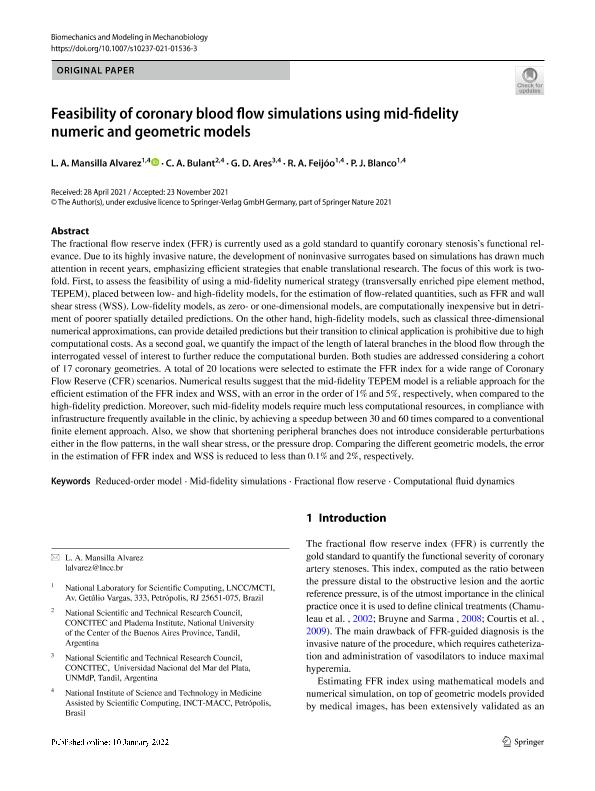Artículo
Feasibility of coronary blood flow simulations using mid-fidelity numeric and geometric models
Mansilla Alvarez, Luis Alonso; Bulant, Carlos Alberto ; Ares, G. D.; Feijóo, Raúl Antonino; Blanco, P. J.
; Ares, G. D.; Feijóo, Raúl Antonino; Blanco, P. J.
 ; Ares, G. D.; Feijóo, Raúl Antonino; Blanco, P. J.
; Ares, G. D.; Feijóo, Raúl Antonino; Blanco, P. J.
Fecha de publicación:
02/2022
Editorial:
Springer Heidelberg
Revista:
Biomechanics And Modeling In Mechanobiology
ISSN:
1617-7959
Idioma:
Inglés
Tipo de recurso:
Artículo publicado
Clasificación temática:
Resumen
The fractional flow reserve index (FFR) is currently used as a gold standard to quantify coronary stenosis’s functional relevance. Due to its highly invasive nature, the development of noninvasive surrogates based on simulations has drawn much attention in recent years, emphasizing efficient strategies that enable translational research. The focus of this work is twofold. First, to assess the feasibility of using a mid-fidelity numerical strategy (transversally enriched pipe element method, TEPEM), placed between low- and high-fidelity models, for the estimation of flow-related quantities, such as FFR and wall shear stress (WSS). Low-fidelity models, as zero- or one-dimensional models, are computationally inexpensive but in detriment of poorer spatially detailed predictions. On the other hand, high-fidelity models, such as classical three-dimensional numerical approximations, can provide detailed predictions but their transition to clinical application is prohibitive due to high computational costs. As a second goal, we quantify the impact of the length of lateral branches in the blood flow through the interrogated vessel of interest to further reduce the computational burden. Both studies are addressed considering a cohort of 17 coronary geometries. A total of 20 locations were selected to estimate the FFR index for a wide range of Coronary Flow Reserve (CFR) scenarios. Numerical results suggest that the mid-fidelity TEPEM model is a reliable approach for the efficient estimation of the FFR index and WSS, with an error in the order of 1 % and 5 % , respectively, when compared to the high-fidelity prediction. Moreover, such mid-fidelity models require much less computational resources, in compliance with infrastructure frequently available in the clinic, by achieving a speedup between 30 and 60 times compared to a conventional finite element approach. Also, we show that shortening peripheral branches does not introduce considerable perturbations either in the flow patterns, in the wall shear stress, or the pressure drop. Comparing the different geometric models, the error in the estimation of FFR index and WSS is reduced to less than 0.1 % and 2 % , respectively.
Archivos asociados
Licencia
Identificadores
Colecciones
Articulos(CCT - TANDIL)
Articulos de CTRO CIENTIFICO TECNOLOGICO CONICET - TANDIL
Articulos de CTRO CIENTIFICO TECNOLOGICO CONICET - TANDIL
Citación
Mansilla Alvarez, Luis Alonso; Bulant, Carlos Alberto; Ares, G. D.; Feijóo, Raúl Antonino; Blanco, P. J.; Feasibility of coronary blood flow simulations using mid-fidelity numeric and geometric models; Springer Heidelberg; Biomechanics And Modeling In Mechanobiology; 21; 1; 2-2022; 317-334
Compartir
Altmétricas



